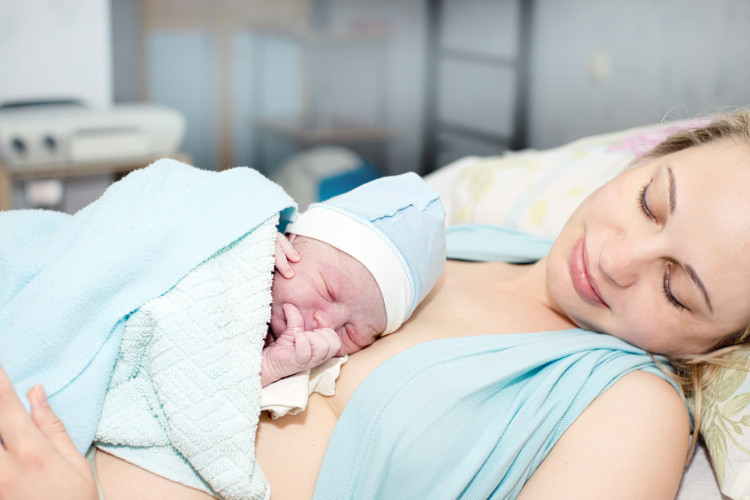Mothers who hug their babies for 60 minutes after birth will reduce the risk of bleeding
Skin-to-skin contact with a child helps the mother's uterus to contract well, avoiding the risk of postpartum haemorrhage.
Dr. Tran Thi Kim Xuyen, Head of the Department of Obstetrics and Gynecology, Ho Chi Minh City CIH Hospital, said that skin-to-skin contact between mother and infant brings many benefits, such as increasing the desire to breastfeed the baby and the baby. less crying. Research shows that children who apply this method have a more stable heart rate and regular breathing. Your baby's skin is also exposed to beneficial bacteria on the mother's body, thereby increasing resistance and fighting infection.
In addition, skin-to-skin contact with the mother immediately after birth also helps children avoid hypothermia and respiratory failure. At this time, the child receives an additional amount of blood from the mother, increasing the amount of iron for the body to store for 6 to 8 months, thereby avoiding the risk of anemia.

Skin-to-skin method is good for both mother and newborn baby.(Photo: Health).
According to Dr. Xuyen, (or early essential neonatal care) simply puts the newborn on the bare chest of a pregnant woman. The child's chest, abdomen and legs are close to the mother's, there is no space, the baby's head is tilted to one side. The upper body of the child is covered with a warm blanket. The mother's bare chest is the most perfect place to help babies recover from the stresses of the 'runaway' journey . Unless immediate medical intervention is needed, all babies should be rested on their mothers' breasts for at least one hour after the baby is born.
Department of Maternal and Child Health (Ministry of Health) provides 6-step skin-to-skin procedure, following the standards of the World Health Organization (WHO) as follows:
Step one
Immediately after the pregnancy, immediately dry the whole body within 30 seconds, at the same time determine the sex, the time of birth (hours, minutes, seconds). Then put the baby on his stomach on the stomach, skin-to-skin contact, cover dry towel to keep warm, instruct the mother how to hold the baby and conduct a baby's respiratory assessment.
Step two
Check the uterus to make sure you're not pregnant anymore. Conduct thigh injection 10 IU Oxytocin.
Step three
Wait for the umbilical cord to stop beating (from one to three minutes), proceed to clamp the umbilical cord from 2 to 5 cm from the umbilical cord, cut in the middle of the two clamps.
Step four
Controlling the umbilical cord is controlled while the child is still on the mother's chest.
Step five
After the placenta, rub the uterus bottom every 15 minutes for the first 2 hours after birth, ensuring good uterus and follow up bleeding.
Step six
Instruct the mother to show signs that the baby is ready to breastfeed. Children should be breastfed early and completely during the first hour after birth. Usually after 20 to 60 minutes, the baby will have a reflex reflex. Performing skin-to-skin care at least 90 minutes after birth, other neonatal care should be performed after the first breastfeeding.
According to Dr. Xuyen, skin-to-skin methods are not only meaningful to babies but also good for women. Specifically, helping the uterus of women recover well, avoiding postpartum haemorrhage, facilitating breast-feeding, prolonging periods of amenorrhea. Many mothers shared that the most sacred moment of childbirth was to hear the baby crying, giving her the first hug to feel the warmth through her mother's arms. At that time, all pain was gone.
In the case of women feeling unwell or anesthetic still works, he can also replace his mother to skin-to-skin contact with the baby. This is a good opportunity for the father to interact with the child. Holding babies, skin-to-skin help calm children, reduce crying and facilitate the development of behaviors before breastfeeding.
'Continuous skin-to-skin contact also helps my father and my child connect. The baby will feel safe on his father's chest and vice versa, he will also learn how to recognize his signals, ' Dr. Xuyen said.
- My mother has H1N1 flu, my baby is dead easily
- Air pollution increases the risk of low birth weight babies
- The secret of babies
- Evening bottle-fed babies are prone to tooth decay
- You can apply the creation of babies from a father and a mother
- Breastfed babies will reduce their risk of obesity by 50%
- Mother elected to eat low-fat yogurt, easily prone to asthma
- Research: Mothers just need to wait for 1 year to have the next baby
- Vitamin A reduces the risk of infant mortality
- Spinal anesthesia for pain relief can be difficult to breastfeed
- Born 5 babies in 4 minutes
- False nipples prevent mother-to-child transmission of HIV
 Green tea cleans teeth better than mouthwash?
Green tea cleans teeth better than mouthwash? Death kiss: This is why you should not let anyone kiss your baby's lips
Death kiss: This is why you should not let anyone kiss your baby's lips What is salmonellosis?
What is salmonellosis? Caution should be exercised when using aloe vera through eating and drinking
Caution should be exercised when using aloe vera through eating and drinking